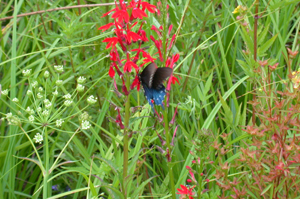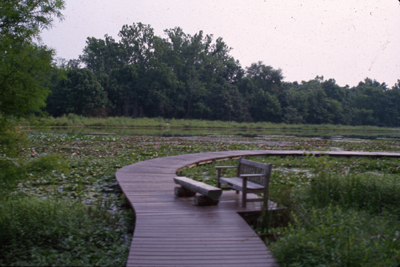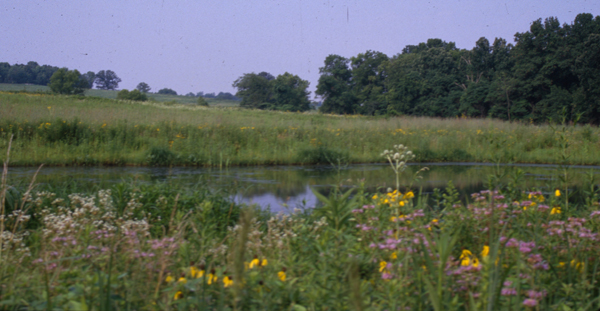Features, physical
The donor-funded wetland complex at Shaw Nature Reserve was implemented as a means of diversifying birding opportunities in the early 1990s. Wood ducks, hooded mergansers, herons, belted kingfishers, and of course, Canada geese are water-associated birds that are common visitors to these wetlands. Blue-winged teal, shoveler ducks, solitary sandpipers, snipe and occasional others are notable migrant visitors, especially in late winter/spring. The prairie, with scattered trees that constitutes the watershed for the wetlands and through which the Wetland Trail proceeds from the Loop Road parking area out to the boardwalk, abounds in a variety of sparrows, indigo buntings, northern yellowthroats, blue-winged warblers, orchard and Baltimore orioles, bluebirds and various woodpeckers.
The wetland complex itself is 32 acres in size with 8 ponds. Two ponds hold water all year round, while a third one holds at least a puddle of water in its deepest part. The others are shallower, and by design, go dry anywhere from late spring to late summer. Also included is a wet meadow area that remains saturated for a few days to several weeks after rainy periods. A 300-ft boardwalk passes through swampy woods, then opens out onto the lily-studded pond. These separate pools provide variation in hydroperiod (duration of wetness), creating aquatic habitats that accommodate everything from fish, frog, and dragonfly species that have a larval stage lasting longer than one year while also providing habitat for amphibians (salamanders, toads and smaller frog species) as well as aquatic insects that mature in a single season. The wet meadow and swamp areas provide habitat for a variety of plants not found in abundance elsewhere on the Reserve.
 Botanical highlights
Botanical highlights
The prairie plantings of the wetlands’ watershed are some of the most diverse at Shaw Nature Reserve. They are notable for the spring flora, including lousewort, paintbrush, downy phlox, blue-eyed grass, yellow stargrass, shooting star and wild hyacinth. The wet meadow and pond edges are home to numerous rare sedge and wetland grass species, and broadleaf beauties such as blue flag iris, queen-of-the-prairie, bunch lily, blue bottle gentian, and three members of the parsley family which require “wet feet”, water parsnip, water hemlock and cowbane. The swamp forest hosts plantings of bald cypress, water tupelo and overcup oak, with an understory of corkwood, swamp loosestrife (the native one, of course!), and two species of hibiscus, underlain by carpets of lizardtail, water pepper, pickerelweed and copper iris.
This area can be easily accessed from the Gardenway Bus Stop parking area and walking along the one-mile out and back wetland trail.


Back to Top